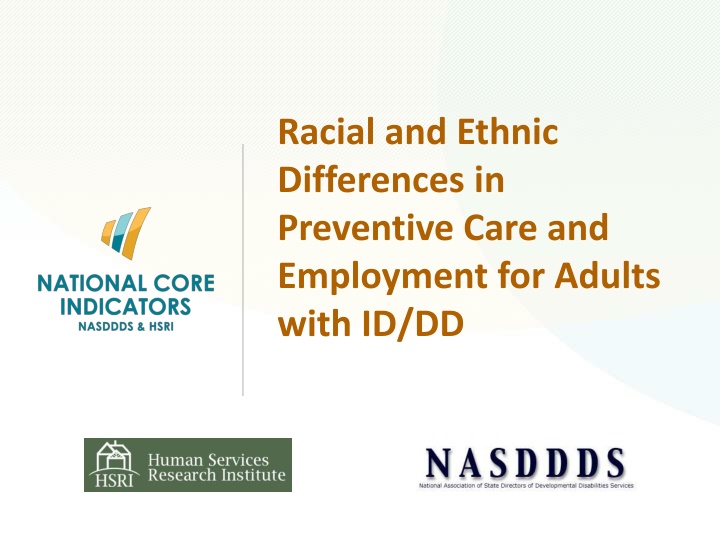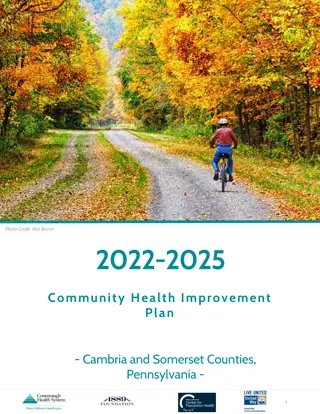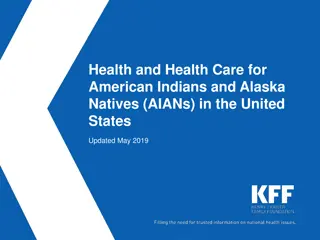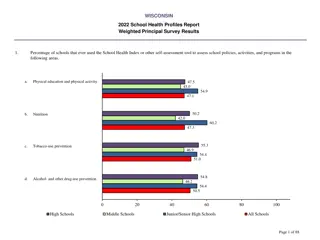
Racial and Ethnic Disparities in Preventive Care and Employment for Adults with ID/DD
Explore the research findings on racial and ethnic differences in preventive healthcare and employment for adults with intellectual and developmental disabilities. The study utilizes data from the National Core Indicators (NCI) program to examine disparities in access and outcomes. Learn about the NCI's role in assessing public systems and measuring performance in various crucial areas.
Download Presentation

Please find below an Image/Link to download the presentation.
The content on the website is provided AS IS for your information and personal use only. It may not be sold, licensed, or shared on other websites without obtaining consent from the author. If you encounter any issues during the download, it is possible that the publisher has removed the file from their server.
You are allowed to download the files provided on this website for personal or commercial use, subject to the condition that they are used lawfully. All files are the property of their respective owners.
The content on the website is provided AS IS for your information and personal use only. It may not be sold, licensed, or shared on other websites without obtaining consent from the author.
E N D
Presentation Transcript
Racial and Ethnic Differences in Preventive Care and Employment for Adults with ID/DD
Agenda Research Questions Data source Preventive Health Care Methods, Measures and Sample Findings Conclusions Limitations Employment Methods, Measures and Sample Findings Conclusions Limitations National Core Indicators (NCI)
Research Questions Do NCI data demonstrate differences by race/ethnicity in use of preventive healthcare? Do NCI data demonstrate differences by race/ethnicity in employment? National Core Indicators (NCI)
WHAT IS NATIONAL CORE INDICATORS (NCI)? Multi-state collaboration of state DD agencies Measures performance of public systems for people with intellectual and developmental disabilities Assesses performance in several areas, including: employment, community inclusion, choice, rights, and health and safety Launched in 1997 in 13 participating states Supported by participating states NASDDDS HSRI Collaboration National Core Indicators (NCI)
NCI State Participation 2013-14 ME NH WA MA MN OR NY WI SD MI PA NJ OH* DE MD IN IL UT VA Wash DC CO CA* KS KY MO NC TN OK SC AR AZ NM GA AL MS 39 states, the District of Columbia and 22 sub-state regions LA TX FL HI State contract awarded in 2013-14 through AIDD funding CA*- Includes 21 Regional Centers OH*- Also includes the Mid-East Ohio Regional Council
WHAT IS NCI? Adult Consumer Survey In-person conversation with a sample of adults receiving services to gather information about their experiences Keyed to important person-centered outcomes that measure system-level indicators related to: employment, choice, relationships, case management, inclusion, health, etc. Adult Family, Child Family, and Family/Guardian Surveys Mail surveys separate sample from Adult Consumer Survey Other NCI state level data: Mortality, Staff Stability National Core Indicators (NCI)
Data Source: Adult Consumer Survey Standardized, face-to-face interview with a sample of individuals receiving services Background Information Section I (no proxies allowed) Section II (proxies allowed) No pre-screening procedures Conducted with adults only (18 and over) receiving at least one service in addition to case management Section I and Section II together take 50 minutes (on average) National Core Indicators (NCI)
Do NCI data demonstrate differences by race/ethnicity in use of preventive healthcare?
Methods, Measures and Sample: 2011-2012 data collection cycle of the Adult Consumer Survey Background Information section: demographics, residence, health, and employment information. Generally collected from records by case managers. 19 states, one regional council (AL, AR, AZ, CT, GA, HI, IL, KY, LA, MA, ME, MI, MO, NC, NJ, NY, OH, PA, SC and the Mid-East Ohio Regional Council) Total N: 12,236 individuals National Core Indicators (NCI)
Methods, Measures and Sample: Race/Ethnicity Source: two items from Background Section Ethnicity (Hispanic, or non-Hispanic) Race (American Indian or Alaska Native, Asian, Black or African American, Pacific Islander, White, or Other race not listed) Items combined to create: Race/Ethnicity White, Non-Hispanic African American, Non-Hispanic Hispanic Other race/ethnic categories too small for analysis National Core Indicators (NCI)
Methods, Measures and Sample: Preventive Care Person has a primary care doctor: No Yes Last hearing test: Within the past 5 years 5 years ago or more (or never) Last complete annual physical exam (routine): In the past year One year ago or more Flu vaccination in the past 12 months: Yes No Ever had a vaccination for pneumonia: Yes No Last dentist visit: In the past year One year ago or more Last eye exam/vision screening In the past year One year ago or more Don t know responses were excluded from these analysis i.e. excluded from both denominator and numerator National Core Indicators (NCI)
FINDINGS National Core Indicators (NCI)
Race/Ethnicity of Sample Race/Ethnicity Percent of total African American, Non- Hispanic Hispanic 20 % 5% White, Non-Hispanic 75% Total (N=11,199) 100.0% African American, Non-Hispanic Hispanic 20% 5% 75% White, Non- Hispanic National Core Indicators (NCI)
Preventive Care: Primary Care Doctor (p < .001) 97% 96% 100% 92% 90% 80% 70% 60% 50% 40% 30% 20% 10% 0% White, Non-Hispanic African American, Non- Hispanic Hispanic National Core Indicators (NCI)
Preventive Care: Physical Exam in Past Year (p < .001) Dentist Visit in Past Year (p < .001) 100% 100% 92% 89% 90% 90% 85% 85% 79% 80% 80% 75% 70% 70% 60% 60% 50% 50% 40% 40% 30% 30% 20% 20% 10% 10% 0% 0% White, Non- Hispanic African American, Non-Hispanic Hispanic White, Non- Hispanic African American, Non-Hispanic Hispanic National Core Indicators (NCI)
Preventive Care: Flu vaccine in past year (p < .001) Ever had pneumonia vaccine (p < .001) 100% 100% 90% 90% 81% 80% 80% 74% 71% 70% 70% 60% 60% 50% 50% 45% 40% 40% 35% 34% 30% 30% 20% 20% 10% 10% 0% 0% White, Non- Hispanic African American, Non-Hispanic Hispanic White, Non- Hispanic African American, Non-Hispanic Hispanic National Core Indicators (NCI)
Small Area Variation Rates of health care use vary over well-defined geographic areas. Significant variation has been shown to exist in the rates of hospitalization for diagnoses such as: chronic obstructive lung disease, pneumonia, hypertension, surgical procedures. Potential sources of variation include differences in underlying morbidity, access to care, physician judgment, quality of care delivered, patient demand for services, and random variation, etc. Need to control for State of residence. Parchman, M. (1995) Small area variation analysis: A tool for primary care research. Family Medicine Journal. 27(4): 272-6 National Core Indicators (NCI)
Preventive Care: Simple binary logistic regression (odds ratios) Controlling for state only (coefficients for state not shown) Primary care doc Phys exam ref 0.70* 0.62* Dental exam Flu vacc ref 0.57* 0.72 Pneum vacc White, Non-Hispanic African American, Non-Hispanic Hispanic ref 1.28 1.33 ref ref 0.61* 0.65* 0.72* 0.67* * p<.01 National Core Indicators (NCI)
Controlling for State of Residence African American, Non-Hispanic respondents are significantly less likely than White, Non-Hispanic respondents to have: Had a physical exam in the past year Had a dental exam in the past year Had a flu vaccine in the past year Ever had a pneumonia vaccine Hispanic respondents are significantly less likely than White, Non-Hispanic respondents to have: Had a physical exam in the past year Had a flu vaccine in the past year Ever had a pneumonia vaccine National Core Indicators (NCI)
BUT Differences may be due to other demographic characteristics. The following demographic variables were tested and found to be significantly different among the three racial/ethnic categories: Age Gender Individual s primary language Individual s primary means of expression Level of intellectual disability Mobility Other diagnoses (in addition to ID/DD) Residence type National Core Indicators (NCI)
Demographic Differences: Average Age (p < .01) Gender, FEMALE (p < .01) 100% 49 90% 47 80% 70% 44.9 45 60% 43 50% 45% 41% 41.0 37% 41 40% 30% 39 37.8 20% 37 10% 35 0% White, Non- Hispanic African American, Non-Hispanic Hispanic White, Non- Hispanic African American, Non-Hispanic Hispanic National Core Indicators (NCI)
Demographic Differences: Primary language NON-ENGLISH (p < .01) Primary means of expression (p<.01) 100% 100% White, Non- Hispanic 90% 90% 78% 80% 74% 80% 71% African American, Non- Hispanic Hispanic 70% 70% 60% 60% 50% 40% 50% 30% 40% 23% 22% 18% 20% 30% 21% 3% 10% 3% 2% 2% 1% 1% 1% 1% 1% 20% 0% 10% 1% 1% 0% White, Non- Hispanic African American, Non-Hispanic Hispanic National Core Indicators (NCI)
Demographic Differences: Level of Intellectual Disability (p < .01) 100% White, Non- Hispanic 90% 80% African American, Non-Hispanic 70% 60% Hispanic 50% 38% 40% 33% 33% 32% 30% 28% 30% 16% 15% 20% 14% 13% 12% 12% 10% 4% 3% 3% 3% 1% 2% 2% 2% 2% 0% n/a - no ID label Mild ID Moderate ID Severe ID Profound IDUnspecified ID level unknown level National Core Indicators (NCI)
Demographic Differences: Mobility level (p < .01) 100% 90% White, Non- Hispanic African American, Non-Hispanic Hispanic 81% 81% 75% 80% 70% 60% 50% 40% 30% 15% 20% 11% 11% 10% 8% 8% 10% 0% Moves self around environment without aids Moves self around environment with aids or uses wheelchair independently Non-ambulatory, always needs assistance person s mobility National Core Indicators (NCI)
Demographic Differences: Other diagnoses 100% White, Non- Hispanic African American, Non-Hispanic Hispanic 90% 80% 70% 60% 50% 36% 40% 30% 29% 30% 20% 14% 14% 11% 11% 8% 6% 6% 5% 10% 4% 0% Autism-Spectrum Disorder (p < .01) Mental Illness or Psychiatric Diagnosis (p < .01) Hearing loss- severe or profound (p < .01) Down Syndrome (p < .01) National Core Indicators (NCI)
Demographic Differences: Residence Type (p < .01) 100% White, Non- Hispanic 90% 80% African American, Non-Hispanic 70% Hispanic 60% 47% 50% 41% 41% 40% 33% 33% 30% 30% 20% 12% 13% 8% 10% 5% 5% 5% 5% 5% 5% 4% 3% 3% 0% Institution Community-Based Residence Independent Home/apt Parent/relative s home Foster care/host home other National Core Indicators (NCI)
We see There are significant differences in demographic characteristics amongst individuals of differing races/ethnicities. Could those differences be influencing the racial and ethnic disparities we see in preventive healthcare use? Logistic regression to control for these demographic differences. National Core Indicators (NCI)
Primary care doc Phys exam Dental exam Flu vacc Pneum vacc Logistic Regression Results *** *** *** *** *** State Race White, Non-Hispanic African American, Non-Hispanic Hispanic ref 1.6 0.9 1.01 0.81 1.33 ref ref ref ref 0.82 0.95 1.01* 1.06 0.37* 0.60* 0.86 0.99* 1.02 0.52* 0.68* 0.8 1.03* 1.18 0.87 0.83 0.9 1.04* 1.05 1.04 Age Gender: Female Primary Language: Not English Level of ID Level ID: No ID Level ID: Mild ID Level ID: Moderate ID Level ID: Severe ID Level ID: Profound ID 1.03 0.64 0.67 0.45 Ref 1.46 1.11 1.15 1.34 Ref 1.07 0.84 0.89 0.8 Ref 0.53* 0.68 0.8 0.81 Ref 1.07 0.78 0.87 1.09 Ref Other diagnosis: ASD Other diagnosis: Mental Ill Other diagnosis: Hearing loss 1.09 0.72 0.97 1.89 1.37 1.03 1.96 1.12 1.2 1.14 1.09 1.02 1.09 1.19 1.11 1.23 0.89 1.21 1.19 1.21 Other diagnosis: Down Residence Type Residence Type: Institution Residence Type: Community Based Residence Residence Type: Independent home/apt Residence Type: Parent/relative's home Residence Type: Foster care/Host home Residence Type: other ref ref ref ref ref 1.03 0.85 0.89 0.85 1.45 0.78 0.28* 0.21* 0.45 0.46 0.47* 0.15* 0.11* 0.24* 0.35* 0.42* 0.17* 0.14* 0.22* 0.39* 0.79 0.60* 0.60* 0.74 0.89 Mobility 0.81 1.13 ref 1.18 1.46 0.83 0.9 ref 0.75 1.06 1.26 1.11 ref 0.95 1.05 0.61* 0.88 ref 1.06 1.14 0.43* 0.71 ref 0.74* 1.16 Mobility: Moves self without aids Mobility: Moves self with aids Mobility: Non-Ambulatory Expression: Spoken * p < .01 Support for behav. problems National Core Indicators (NCI)
Controlling for State & Demographics Race/ethnicity is still a significant predictor for : Has had dentist visit in past year African American, Non-Hispanic respondents are significantly less likely to have had a dentist visit in the past year Has had flu vaccine in past year African American, Non-Hispanic respondents are significantly less likely than White, Non-Hispanic respondents to have had a flu vaccine in the past year Controlling for other demographic factors, race/ethnicity is no longer a significant predictor for: Has primary care doctor Has had physical exam in past year Has ever had pneumonia vaccine National Core Indicators (NCI)
Conclusions: There are apparent differences in likelihood of receiving preventive care by race/ethnicity White, Non-Hispanic respondents less likely to have a primary care doc White, Non-Hispanic respondents more likely to have had a physical exam, a dental exam, a flu vaccination and/or a pneumonia vaccination Adults with IDD of different racial/ethnic backgrounds also differ in other demographic factors Where they live (both type of residence and state of residence) Their age Their means of expression Their language Their level of ID Other diagnoses Their level of mobility It is crucial to control for these demographic factors. National Core Indicators (NCI)
Conclusions: After controlling for demographics and state: Many differences observed in descriptive analyses are no longer significant. However, some differences remain: Race/ethnicity is still a significant predictor for : Has had dentist visit in past year African American, Non-Hispanic respondents are significantly less likely to have had a dentist visit in the past year Has had flu vaccine in past year African American, Non-Hispanic respondents are significantly less likely than White, Non- Hispanic respondents to have had a flu vaccine in the past year National Core Indicators (NCI)
Conclusions: State in which individual resides is a highly significant predictor of receipt of all preventive care variables. Residence type is strongly related to use of preventive care. Speaking a language other than English has a negative effect on receipt of a physical exam in the past year and receipt of a dental exam in the past year Individuals with less mobility are significantly more likely than those who are self-mobile (without using aids) to have been vaccinated against the flu and pneumonia. Age is significantly related to receipt of physical exam, dentist visit and flu and pneumonia vaccines. National Core Indicators (NCI)
Do NCI data demonstrate differences by race/ethnicity in employment?
Methods, Measures and Sample: 2011-2012 data collection cycle Background Information section: demographics, residence, health, and employment information. Generally collected from records by case managers. Section I: Face-to-face interview: Satisfaction and preferences 19 states, one regional council (AL, AR, AZ, CT, GA, HI, IL, KY, LA, MA, ME, MI, MO, NC, NJ, NY, OH, PA, SC and the Mid-East Ohio Regional Council) Total N: 12,236 individuals National Core Indicators (NCI)
Methods, Measures and Sample: Race/Ethnicity Source: two items from Background Section Ethnicity (Hispanic, or non-Hispanic) Race (American Indian or Alaska Native, Asian, Black or African American, Pacific Islander, White, or Other race not listed) Items combined to create: Race/Ethnicity White, Non-Hispanic African American, Non-Hispanic Hispanic Other race/ethnic categories too small for analysis National Core Indicators (NCI)
Methods, Measures and Sample: Employment Person has paid job in the community: No Yes Person does not have a paid job in the community, but would like one: No Yes Person has paid job in the community but would like to work somewhere else: No Yes Hours worked and hourly wages Continuous National Core Indicators (NCI)
FINDINGS National Core Indicators (NCI)
In paid community job in the past 2 weeks (no significance) 100% 90% 80% 70% 60% 50% 40% 30% 16.4% 20% 13.3% 13.1% 10% 0% White, Non-Hispanic African American, Non-Hispanic Hispanic National Core Indicators (NCI)
Doesnt Have Paid Community Job, But Wants Paid Community Job (p<.001) 100% 90% 80% 70% 56.5% 60% 45.9% 50% 43.5% 40% 30% 20% 10% 0% White, Non-Hispanic African American, Non- Hispanic Hispanic National Core Indicators (NCI)
Has Paid Community Job, Wants to Work Somewhere Else (p<.001) 100% 90% 80% 70% 60% 50% 43.2% 36.8% 40% 30% 25.1% 20% 10% 0% White, Non-Hispanic African American, Non- Hispanic Hispanic National Core Indicators (NCI)
Wages and Hours: Paid Community Jobs Average number of hours worked in a two week period (p<.001) Average hourly wage (p<.001) White, Non- Hispanic 25.86 $7.83 African American, Non-Hispanic 28.87 $8.60 Hispanic 36.15 $6.64 National Core Indicators (NCI)
Regressions Controlling for state only (coefficients for state not shown) Not in job, would like Has a job, wants to work somewehere Hours Hourly wage worked in two week period job else ref White, Non-Hispanic ref ref ref African American, Non-Hispanic 1.63*** 2.50*** 3.51 0.13 Hispanic 1.29 1.75 7.90** -1.3 ***p<.001 **p<.01 National Core Indicators (NCI)
Conclusions After controlling for state: African American, Non-Hispanic respondents are significantly more likely to want a job (if not working) and to want a different job (if working). Hispanic respondents work significantly more hours than White, Non-Hispanic respondents. Too few degrees of freedom to control for demographic factors Expect results regarding the influence of race/ethnicity to be similar to the initial analyses. Future research should examine differences in employment among race/ethnicities. National Core Indicators (NCI)
Limitations Don t know responses are excluded from analyses. For some health care and employment variables, the rate of don t know responses are fairly high. Data less likely to be available in independent/family home settings i.e. higher rates of don t know responses. In preventive care examination, choice is not taken into account - what if person does not want to get a specific test? There may be other pertinent factors affecting likelihood of receipt of care and employment that were not controlled for. For example, no data available on income or SES. Previous research has shown that racial/ethnic disparities are often confounded by disparities based on SES. Standards regarding recommended frequency of preventive care used are for general population. It s important to continue research on these topics in order to inform the development of more targeted education and outreach. National Core Indicators (NCI)
Contacts HSRI Josh Engler: jengler@hsri.org Dorothy Hiersteiner: dhiersteiner@hsri.org NASDDDS Mary Lee Fay: MLFay@nasddds.org NCI website: www.nationalcoreindicators.org National Core Indicators (NCI)






















